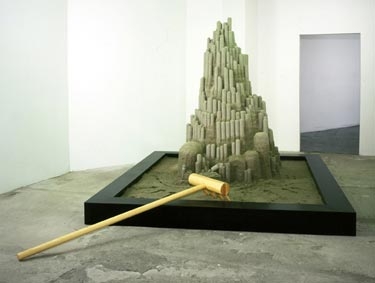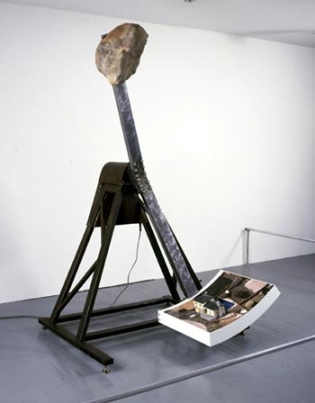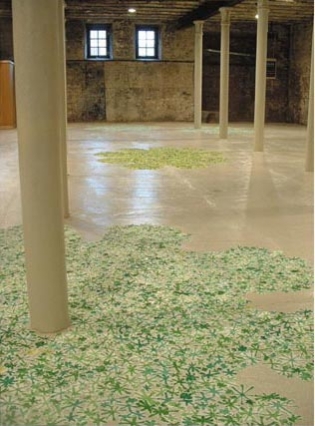Feature: Reviews
Northern Frontier
Glenn Kaino and Polly Apfelbaum on West 126th Street
Will West Harlem ever go the way of Chelsea? Hard to say. Certainly no time soon, what with the economy in a graceless nosedive, property taxes skyrocketing, and New York City facing some pretty scary tax and budget cuts. Still, you never know. And if Harlem ever does blossom into a new Chelsea, then West 126th Street, replete with abandoned factory buildings and empty lots, is on track to become the new West 26th Street. Already, the street is home to two galleries, Triple Candie and The Project, both located on the block between Amsterdam and Morningside Avenues.
The Project is the elder of the two. Founded in 1998 by Christian Haye, it has played host to local and international artists alike, as has its sister gallery in Los Angeles. On view recently were two sculptures by Glenn Kaino, a Los Angeles-based artist who has recently exhibited his work in California, New York, and the Netherlands. His massive sand sculpture, Desktop Operation; There’s no place like Home (10th example of Rapid Dominance: Em City) (2003) dominates the gallery’s first floor. Shaped like a jagged Chinese mountain, Desktop Operation plays quite cleverly with the idea of the Japanese karesansui, or dry landscape garden. These small “gardens,” on which sand is raked and piled to represent mountains surrounded by the sea, are meant to invite quiet contemplation. Today, miniature desk-sized versions of karesansui are a popular item in the cubicles of overworked Japanese salarymen. Yet whereas the traditional karesansui creates an atmosphere of tranquility, Kaino’s version of the Japanese sand garden provokes a distinct sense of unease. Desktop Operation’s towering city rises out of a standard-sized sandbox upon which rests an enormous and menacing wooden rake. Instead of the smooth naturally-formed curves that characterize karesansui, Kaino uses sharp, knife-cut lines and angles to shape his craggy city. There is something palpably dangerous, almost militaristic about this tower, with its missile-shaped projections and hard edges. Bathed in an eerie green light, Kaino’s Emerald City speaks not of Hollywood magic, but of American industrial might. Yet Desktop Operation’s power is a mere illusion; in reality, it is a sculpture of sand, slowly but continuously shifting and eroding.
Upstairs, Kaino has installed Revolution… (2003), a mobile sculpture that conflates several interpretations of the word “revolution.” In this sculpture, a miniature model of a split-level suburban home with a sky-blue swimming pool is attached to one end of a rotating propeller, while on the other end is a dusty brown boulder. Clicking audibly as it turns, the propeller rotates at a speed of 40 rpm - slowly enough for viewers to glimpse the boulder and house model, but far too fast to note any details. Interestingly, the swimming pool contains real water; thanks to centripetal force, the water sloshes tantalizingly but never spills. Revolution… thus presents a literal revolution, or turning. It also implies revolution in the sense that the American Dream-style house, continuously chased by the boulder, remains always threatened with a disastrous change. And finally, the machine quality of the sculpture — the rapidly spinning propeller on its riveted iron base — calls to mind the Industrial Revolution, a revolution whose consequent factories and power tools made possible idyllic split-level suburban home such as the one menaced in Kaino’s sculpture.
Just a few steps away from The Project is Triple Candie, a former brewery across the street from the foul-smelling La Granja Live Poultry Shop (from which emanate disgruntled squawks and clucks). It opened in December 2001 with an exhibition sponsored by the Jacob and Gwendolyn Lawrence Foundation, taking its name from a bodega that used to be on nearby St. Nicholas Avenue. The bodega’s old metal sign now hangs proudly in the gallery’s foyer. Since its inception, Triple Candie has marketed itself as a satellite location for prominent downtown galleries, such as Pace Wildenstein, which recently hosted a Kiki Smith exhibition in Triple Candie’s space. D’Amelio Terras, another big Chelsea name, is sponsoring the current Triple Candie show: Polly Apfelbaum’s Today I Love Everybody.
True to its origins, Triple Candie retains the brewery’s open industrial space, high ceilings, and exposed brick walls slathered with cheap, peeling whitewash. A series of thin, elegant columns, obviously installed post-brewery, divides the space into nave and side-aisles. Scattered in a seemingly random arrangement on the floor around these columns is Apfelbaum’s site-specific installation, which comprises a number of asterisk-shaped fabric collages in varying shades of green. Each collage is made up of hundreds of hand-cut swaths of fabric with abstractions of flowers and stars sewn onto them. The overall shape of the collage reflects the shape of its individual parts. Pooling like spilled paint on the dull cement floor, Apfelbaum’s collages gently guide the viewer around the gallery, creating a gradual awareness of its vast and overwhelmingly bare expanses. The contrast between her almost two-dimensional floor collages and the voluminous “industrial cathedral” space is stunning.
Though both The Project and Triple Candie are wonderful examples of “frontier” galleries, they are by no means the be all and end all of the Harlem arts scene. Recently, the Sugar Hill Art Center opened on Broadway near 151st Street, and the Museum for African Art, currently in Soho, has plans to relocate to East 110th Street in late 2004. Furthermore, an increasing number of artists is converting some of Harlem’s more dilapidated commercial and industrial lofts into studio space. Of course, this artistic activity is nothing new. Harlem has long been home to renowned visual and performing arts institutions, such as The Apollo Theatre and the 33-year old Studio Museum, both located on West 125th Street. It lays claim to a long heritage of artistic achievement and renewal that stretches back to and perhaps even earlier than the Harlem Renaissance of the 1920s and 1930s. Only the naive would dare refer to Harlem as “up and coming”; the rest of us know that Harlem is already there.
The Project
427 West 126th St. (between Morningside and Amsterdam)
(212) 662-8610
www.elproyecto.com
Triple Candie
www.triplecandie.org



